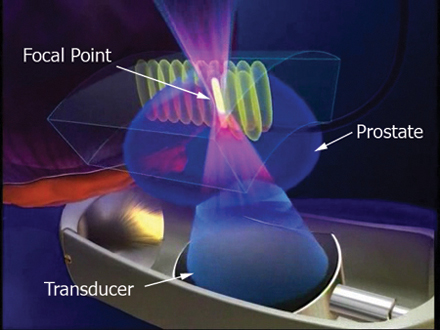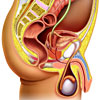Introduction to high intensity focused ultrasound (HIFU)
- What is HIFU?
- How does HIFU work?
- Who can use HIFU?
- Contraindications for HIFU
- What happens during the procedure?
- Complications of HIFU
- Results
- Conclusion
Introduction to high intensity focused ultrasound (HIFU)
The prostate gland is a male accessory sex gland, responsible for secreting an alkaline fluid that forms part of semen (see male urogenital system). Cancer of the prostate gland is a leading cause of death in Australian men, responsible for more than 2,500 deaths a year. This cancer becomes more prevalent as the population becomes older in age. Prostate cancer may cause the prostate gland to enlarge, resulting in symptoms such as difficulty in urinating, frequently needing to urinate, and blood in the urine.
There are many treatment options available to treat prostate cancer, including: surgical removal, radiotherapy directed at the prostate gland, hormonal therapy, or ‘watchful waiting’ – ie a wait and see approach. With surgical treatment, there are possible side effects such as impotence (difficulty obtaining and maintaining an erection), and urinary incontinence (the involuntary passage of urine, resulting in wetting). This is unacceptable to many patients and regardless of how skilled the surgeon is, or what technique is used, these side effects are present. Furthermore, the cancer may have spread beyond the prostate gland, thus there is no guarantee that the surgeon will be able to remove all of the cancer. This ‘risk versus reward’ balance is of great concern to patients and has prompted the development of newer, less invasive treatments.
What is HIFU?
A technique called high intensity focused ultrasound (HIFU) represents the next generation of minimally invasive treatments for early, localised prostate cancer. HIFU is currently being used in many countries, including: Europe, Canada, Japan, China, South America and more recently in Australia and South Africa. When patients are carefully selected to undergo this treatment, long term results have been as good as other alternative treatment methods available for treatment of prostate cancer.
How does HIFU work?
When we focus rays of sunlight onto a leaf, we can burn a hole in that leaf. A probe that contains the equipment for the procedure is inserted into the area through the rectum (back passage). The probe gives out a beam of ultrasound, which is focused so that it heats and destroys the prostate tissue with the cancer. This causes the affected cells in the prostate to die.
There have been studies performed in both animals and humans, which have confirmed the ability of HIFU to cause cell and tissue death. With the advanced computer systems available today, and under the guidance of ultrasound techniques, the prostate can be targeted in small areas. Eventually it is destroyed from end to end and from side to side. This procedure takes about 2-3 hours.
The following diagram shows how the ultrasound beam travels through the transducer probe and is focused into a point, targeting the prostate gland.

(Image courtesy of THS International, Takai Hospital Supply Co., Ltd. Tokyo Japan)
The prostate is located in close proximity to the wall of the rectum. To ensure that there is no damage to the wall of the rectum, there needs to be a cooling device to allow heat to escape. A special device called a Sonochill device circulates ice cold water around the ultrasound probe within a balloon during the treatment. This helps cool the temperature of the wall of the rectum.
Because the probe is quite near the prostate, ultrasound frequencies of 3-4mHz can be used. This means that small, directed rays can be focused onto the prostate and allow the affected tissue to be accurately destroyed.
The advantages of using HIFU include: it is a non-invasive procedure, which does not require any incisions and it is also pain free. The procedure can be performed as a day or overnight treatment, with results similar to other treatments in carefully selected patients. (The criteria for suitable patients are described below). Additionally, there is a better chance that erectile function and continence of urine will be preserved after HIFU, than compared to surgery or radiotherapy.
Who can use HIFU?
HIFU is regarded as suitable for patients with:
- Prostate cancer localised to the prostate;
- Unfit or unwilling to undergo major surgery;
- Age over 70 years;
- Prostate specific antigen (PSA) level < 20;
- Gleason score ≤ 7;
- Prostate gland ≤ 40 cc (grams).
HIFU may be used as an alternative therapy to radiotherapy, or where radiotherapy has failed.
It is important that the prostate volume should be less than 40 grams. If the prostate is larger than 40 grams, the patient will need to be treated with hormonal therapy to make the gland smaller.
Contraindications for HIFU

If the prostate contains any areas of dense deposits of calcium, this may interfere with the ultrasound beam and the treatment will not work properly. Your doctor should be able to tell you if this is the case.
Another factor that may affect the procedure is if there is any narrowing or stricturing in the rectum – this will prevent the ultrasound probe from being placed.
If you have a large prostate with a big middle lobe, the best results will be obtained if this is resected prior to undergoing HFIU.
What happens during the procedure?
Before HIFU is carried out, you will be required to undergo bowel preparation 24 hours prior to the procedure. Your doctor/nurse will tell you what you can and cannot eat and drink.
They will also tell you what bowel cleansing routine to use. The preparation is usually made up of either drinking a large amount of a cleansing drink or clear liquids and some oral laxatives. The rectum must be completely clean for the procedure to be accurate, safe and complete, so be sure to follow the instructions carefully.
HIFU for prostate cancer is carried out under a general anaesthetic. This means that you will be put to sleep. The patient is lying on their back and a balloon is placed over the ultrasound probe, which is then placed in the rectum. The prostate is then imaged in two planes
. After careful planning, your doctor will begin treatment in one of three zones, which will eventually overlap. The prostate is slowly and accurately destroyed. The tissue is closely monitored during treatment with real time ultrasound.
Treatment time varies from between 2 – 3 hours depending on the size of the gland. At the end of the treatment a catheter (a hollow, plastic tube) is placed into the bladder, which will need to remain in place for 10-14 days. The patient is discharged home the same day, and may return to work within 24 hours.
Complications of HIFU
Minor problems after HIFU treatment include:
- Urinary infections;
- Inflammation and irritation of the area around the anus;
- Epididymitis (inflammation of the epididymis, which is the tube connecting the testes to the vas deferens. This tube is where sperm passes through);
- Discomfort around the urethra; and
- Irritation of the bladder.
Immediately after the procedure, passing urine may not be possible due to swelling of the prostate gland. A catheter to help you pass urine will therefore be inserted and remain in the bladder for 10-14 days. In some patients, parts of the urinary system may become narrower as a result of the treatment. A connection between the rectum and urethra may form (known as a rectourethral fistula). Both of these complications are more likely to occur in patients who have had radiotherapy. With improved ultrasound imaging the development of a rectourethral fistula is now rare.
Stress incontinence (leakage of urine when coughing, sneezing or making a sudden movement) is usually secondary to treatment of apical parts of the prostate (ie the tip of the prostate, which sits in contact with the muscle surrounding the urethra and muscles in the pelvis) and is usually transient.
Impotence (the failure to get or maintain an erection) was another problem after the procedure. In a review of 462 patients, 24% experienced erectile dysfunction.
Results

In a study of 72 patients conducted in Japan, by Uchida et al, patients with previously untreated prostate disease and PSA levels < 20 ng/ml were examined. By using the Sonablate 500, a negative post treatment biopsy was achieved in 68% of patients at 14 months.
In a further study, Gelet et al report a five year 78% disease free rate in low risk patients – those with pre-treatment PSA<10ng/ml and Gleason Score 6 or less.
Of 146 patients treated by Blana et al with a pre-treatment PSA of < 15 and a Gleason score of 7 or less, a low level of PSA, at an average of 0.07 ng/ml was reported at 3 months, but 43% of these patients also had hormonal treatment.
Conclusion
HIFU is a relatively new treatment modality for prostate cancer and 10 year outcomes are not yet available. As further developments in both the software and hardware of the HIFU devices emerge, it is likely that the cancer cure rates will improve and side effects decrease. This technique is of increasing interest and currently under ongoing investigation in several centres overseas. Future studies will determine its eventual role in the treatment of prostate cancer.
In carefully selected patients, HIFU offers the potential to eradicate the prostate cancer, with a minimal side effect profile, short hospital stay and an early return to everyday activities.
Article kindly contributed by Editorial Advisory Board member Dr Alistair Cameron-Strange, FRACS (Urology) FRCSEd MBCHB, Senior Consultant Urologist at The Prince of Wales Hospital, Randwick, Sydney. For further information click here.
More information
 |
For more information on prostate cancer, including diagnoses, types of treatments, and some useful tools, videos and animations, see Prostate Cancer. |
References
- Chapelon JY, Margonari J, Vernier F, et al. In vivo effects of high-intensity ultrasound on prostatic adenocarcinoma Dunning R3327. Cancer Res. 1992;52(22):6353-7. [Abstract | Full text]
- Beerlage HP, van Leenders GJ, Oosterhof GO, et al. High-intensity focused ultrasound (HIFU) followed after one to two weeks by radical retropubic prostatectomy: Results of a prospective study. Prostate. 1999;39(1):41-6. [Abstract]
- Uchida T, Ohkusa H, Nagata Y, et al. Treatment of localized prostate cancer using high-intensity focused ultrasound. BJU Int. 2006;97(1):56-61. [Abstract | Full text]
- Uchida T, Baba S, Irie A, et al. Transrectal high-intensity focused ultrasound in the treatment of localized prostate cancer: A multicenter study. Hinyokika Kiyo. 2005;51(10):651-8. [Abstract]
- Gelet A, Chapelon JY, Poissonnier L, et al. Prostate cancer control with transrectal HIFU in 242 consecutive patients: 5-year results. Eur Urol Suppl. 2004;3(2):214. [Full text]
- Blana A, Walter B, Rogenhofer S, Wieland WF. High-intensity focused ultrasound for the treatment of localized prostate cancer: 5-year experience. Urology. 2004;63(2):297-300. [Abstract]
- Uchida T, Shoji S, Nagata Y. HIFU for localized prostate cancer: 6 year experience. Presented at the International Society for Therapeutic Ultrasound (ISTU5) meeting; Boston: 28 October 2005. [Abstract]
All content and media on the HealthEngine Blog is created and published online for informational purposes only. It is not intended to be a substitute for professional medical advice and should not be relied on as health or personal advice. Always seek the guidance of your doctor or other qualified health professional with any questions you may have regarding your health or a medical condition. Never disregard the advice of a medical professional, or delay in seeking it because of something you have read on this Website. If you think you may have a medical emergency, call your doctor, go to the nearest hospital emergency department, or call the emergency services immediately.








